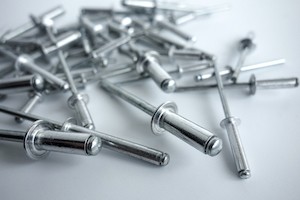A rivet is a permanent mechanical fastener widely used across various industries to join two or more materials together. Known for its ability to withstand vibrations and tension better than screws or bolts, rivets provide reliable and durable connections. This article explores the components of a rivet, its functionality, diverse types, and its extensive applications.
What is a Rivet?
A rivet is a robust mechanical fastener employed to create permanent joints between two or more materials. It comprises a head on one end and a cylindrical shaft extending to the other, terminating in a tapered section known as the tail. Rivets are essential in securing both large structural components and small electronic assemblies. Many rivets feature hollow shafts designed to accommodate a mandrel, an internal element. This mandrel facilitates the deformation of the rivet’s tail by a rivet tool, which clinches and secures the materials without directly hammering the rivet.
How Do Rivets Work?
The application process involves drilling or punching a hole through the materials to be joined. The rivet is then inserted through these aligned holes. Using a hammer or a specialized rivet tool, the tail of the rivet is deformed, a process known as upsetting or buckling. This deformation causes the tail to expand to approximately 1.5 times the original shaft diameter, effectively locking the rivet in place. This process flattens and broadens the tail, creating a dumbbell shape that firmly holds the materials. The original head is referred to as the ‘factory head,’ and the deformed end is called the ‘buck-tail.’
Figure 1: Pop rivets used for joining materials.
Rivets excel in bearing tension at each end of a structure. The heads formed at both ends prevent detachment from the hole, while the shaft restricts radial movement. Although similar to welding or structural adhesives in creating permanent joints, rivets offer superior resistance to vibration.
Figure 2: Securing aluminum components with a rivet gun.
Different Types of Rivets
The broad spectrum of materials needing secure fastening has led to the development of various rivet types, each designed to meet specific requirements.
Solid Rivet
The solid rivet (Figure 3, labeled A) is characterized by its solid shaft and a pre-formed head. The tail of the rivet is deformed using a rivet gun or hammer to secure the joint. Known for their strength and reliability, solid rivets are commonly used in applications where structural integrity is paramount.
Split Rivet
The split rivet (Figure 3, labeled B) features a shaft that is divided, enhancing the surface area once it passes through the materials. This design is particularly effective in securing softer materials like leather, wood, and plastic, preventing the rivet from being pulled back through. Split rivets are typically used for light-duty applications.
Blind Rivet (Pop Rivet)
Blind rivets, also known as pop rivets (Figure 1), are ideal when access to the joint is limited to one side. Installed using a rivet gun, the mandrel is pulled through the rivet’s hollow shaft, deforming the shaft and fastening the materials. The mandrel then snaps off, leaving a clean finish.
Friction Lock Rivet
Friction lock rivets, or self-plugging rivets (Figure 3, labeled C), are a type of blind rivet that utilizes internal pressure to expand the shaft and plug the hole, creating a secure joint. As the stem is drawn through a hollow sleeve, it expands the shaft, applying pressure within the shaft to tightly join the materials and seal the hole.
Self-Piercing Rivet
Self-piercing rivets (SPRs) (Figure 3, labeled D) eliminate the need for pre-drilled holes. Designed with a semi-tubular shape and a grooved end, SPRs pierce the materials during installation, creating a gas- or water-tight seal.
Threaded Rivet
Threaded rivets (Figure 3, labeled E) are blind rivets with internally threaded, hollow shafts. These rivets are installed using a rivet gun that pulls a mandrel through the shaft, upsetting it and creating a solid connection. They often feature external ridges to enhance surface contact within the pilot hole.
Semi-Tubular Rivet
Similar to solid rivets, semi-tubular rivets (Figure 3, labeled F) have a hole at the end of the tail. This hole allows the shaft to roll outward when force is applied, reducing the force required for installation.
Oscar Rivet
An oscar rivet (Figure 3, labeled G) resembles a blind rivet, but the shaft splits and folds out as the mandrel is drawn through. Oscar rivets are well-suited for high-vibration environments where the rear surface is inaccessible.
Figure 3: Various rivet types including solid, split, friction lock, self-piercing, threaded, semi-tubular, and oscar rivets.
How Do Pop Rivets Work?
Pop rivets are a specific type of blind rivet, attached exclusively from one side. The installation process involves:
- Drilling or punching a pilot hole through the materials.
- Inserting the mandrel of the rivet into the rivet gun’s nose piece and pushing the shaft through the holes.
- Compressing the rivet gun trigger to pull the mandrel through the hollow shaft, upsetting the tail end.
- The mandrel snaps off at the “necked” area, completing the joint.
Figure 4: The stages of pop rivet compression and sealing.
How to Calculate Rivet Size
Choosing the correct rivet size, including length and width, is critical for ensuring joint integrity. Key considerations include:
- Length: The rivet length should equal the combined thickness of the materials plus 1.5 times the rivet diameter. Insufficient length can cause pull-through, while an undersized shaft may shear under pressure.
- Diameter: The rivet diameter should be approximately three times the thickness of the thickest material being joined.
For example, when joining two 2 mm thick metal sheets, a 6 mm diameter rivet with a minimum length of 9.5 mm would be suitable.
Advantages and Disadvantages of Rivets
Advantages
- Cost-Effective: Rivets are generally inexpensive fasteners.
- Material Compatibility: They can join dissimilar materials like copper and aluminum.
- Environmentally Friendly: Riveting does not produce fumes or gases like welding.
- Reliable Joints: They provide strong joints, especially under vibration.
- Easy Inspection: Rivet joints are easier to inspect than welded joints.
Disadvantages
- Bulky Joints: Riveted joints can be bulkier than welded joints.
- Aesthetic Impact: The rivet projection can affect appearance.
- Assembly Time: The assembly process can be time-consuming.
- Stress Concentration: Holes for rivets can cause stress concentration.
Rivet Applications
Rivets are commonly used in a diverse range of applications, including:
- Automotive manufacturing
- Household appliances
- Electrical equipment
- Kitchenware
- Aerospace engineering
- Satellite and spacecraft construction
- Shipbuilding and nautical applications
FAQs
What is a rivet?
A rivet is a mechanical fastener used to permanently join two or more materials together.
Are rivet joints strong?
Yes, rivets can create exceptionally strong and permanent joints, preventing movement between the joined materials when properly installed.
Why are blind rivets useful?
Blind rivets are particularly useful because they can be installed from only one side of the materials, eliminating the need for access to the other side for tightening or fastening.

